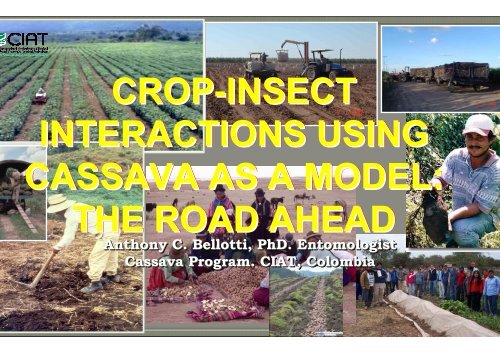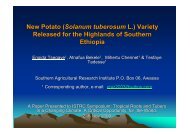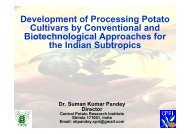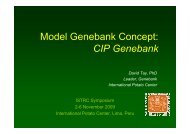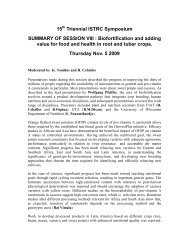Bellotti, A.; Crop-insect interactions using cassava as a model
Bellotti, A.; Crop-insect interactions using cassava as a model
Bellotti, A.; Crop-insect interactions using cassava as a model
You also want an ePaper? Increase the reach of your titles
YUMPU automatically turns print PDFs into web optimized ePapers that Google loves.
CROP-INSECT<br />
INTERACTIONS USING<br />
CASSAVA AS A MODEL:<br />
THE ROAD AHEAD<br />
Anthony C. <strong>Bellotti</strong>, , PhD. Entomologist<br />
C<strong>as</strong>sava Program. CIAT, Colombia
Cont…<br />
MAJOR ARTHROPOD PEST ASSOCIATED WITH FOUR ROOT AND<br />
TUBERCROPS:<br />
CASSAVA, POTATO, SWEET POTATO AND YAMS<br />
CASSAVA<br />
(Manihot esculenta)<br />
POTATO<br />
(Solanum tuberosum)<br />
SWEET POTATO<br />
(Ipomoea batata)<br />
YAM<br />
(Dioscorea spp.)<br />
Whiteflies:<br />
Aleurotrachelus socialis<br />
Bemisia tabaci<br />
Bemisia tuberculata<br />
Trialeurodes variabilis<br />
Bemisia tabaci<br />
Trialeurodes vaporariorum<br />
Bemisia tabaci<br />
Bemisia afer<br />
Mealybugs:<br />
Phenacoccus herreni<br />
Phenacoccus manihoti<br />
Trips:<br />
Franklinella williamsi<br />
Scyrtothrips manihoti<br />
Aphis:<br />
Myzuz persicae<br />
Thrips:<br />
Thrips palmi<br />
Yam mealybug:<br />
Pseudococcus brevipes<br />
Yam tuber scale:<br />
Aspidiella hartii<br />
Cocconut scale:<br />
Aspidiotus destructor<br />
C<strong>as</strong>sava hornworm:<br />
Erinnyis ello<br />
Potato tuber month:<br />
Pthorimaea oporculella<br />
Symmetrichema spp.<br />
Potato month:<br />
Tecia solanivora<br />
Sweet potato hornworm:<br />
Agrius convolvuli<br />
Sweet potato buttlerfly:<br />
Acraea acerata<br />
African cotton leafworm:<br />
Spodoptera littoralis
MAJOR ARTHROPOD PEST ASSOCIATED WITH FOUR ROOT AND TUBERCROPS:<br />
CASSAVA, POTATO, SWEET POTATO AND YAMS<br />
CASSAVA<br />
(Manihot esculenta)<br />
POTATO<br />
(Solanum tuberosum)<br />
SWEET POTATO<br />
(Ipomoea batata)<br />
YAM<br />
(Dioscorea spp.)<br />
ari:<br />
nonychellus tanajoa<br />
tranychus urticae<br />
Leaf minerfly:<br />
Liriomyza huidobrensis<br />
Flea beetles:<br />
Epitrix cucumeris<br />
Epitrix sp.<br />
Tortoise beetles:<br />
Aspidomorpha spp.<br />
Flea beetles:<br />
Epitrix cucumeris<br />
Epitrix sp.<br />
Systena spp.<br />
Gr<strong>as</strong>shoppers:<br />
Zonozerus variegatus<br />
Leafcutter ant.:<br />
Atta sp.<br />
emborers:<br />
ilomima clarkei<br />
Andean weevil:<br />
Premnotrypes vorax<br />
Rhigopsidius piercei<br />
West indian sweet potato weevil:<br />
Euscepes postf<strong>as</strong>ciatus<br />
Sweet potato weevil:<br />
Cyl<strong>as</strong> formicarius<br />
C. puncticollis<br />
C. bruneus<br />
Yam tuber beetle:<br />
Heteroligus meles<br />
Whitefrienged beetle:<br />
Naupactus spp.<br />
il pest:<br />
rtomenus bergi<br />
ite grubs:<br />
yllophaga spp.<br />
Cut worm:<br />
Agrotis ipsilon<br />
Golden nematods:<br />
Globodera rostochiensis<br />
Cut worm:<br />
Agrotis ipsilon<br />
White grubs:<br />
Phyllophaga spp.<br />
Wire worms:<br />
Aelus sp.<br />
Termites:<br />
Amitermes evuncifer<br />
Cricket:<br />
Gymnogryllus lucens<br />
Garden symphylam:<br />
Scutigerella immaculata
YIELD LOSSES RECORDED DUE TO ARTHROPOD DAMAGE ON<br />
ROOT AND TUBER CROPS<br />
CROPS PEST AVERAGE<br />
LOSSSES<br />
C<strong>as</strong>sava<br />
Sweetpotato<br />
Potato<br />
Yams<br />
RANGE<br />
REGION<br />
White flies<br />
Mealybugs<br />
Mites<br />
39% 5 – 80% America /<br />
África<br />
Sweetpotato<br />
weevil<br />
Potato tuber<br />
month<br />
Termites<br />
Beefles<br />
45% 10 – 50% Cuba<br />
50% 11 – 65% Colombia /<br />
India<br />
35% 29 – 42% Africa
RTHROPOD PEST: INCREASED DAMAGE TO ROOT AND TUBER<br />
ROPS<br />
A. The introduction of a pest not native to an area<br />
B. Changes in crop management and production system (eg. Larger<br />
plantation size).<br />
C. Development of resistance in the pest to effective pesticides which<br />
leads to unsuccessful control<br />
D. Climate changes that are conducive to incre<strong>as</strong>ed pest frequency<br />
and population
CLIMATE CHANGES: Arthropod Pests<br />
1. Altered Rainfall Patterns and Temperature Changes:<br />
a) Relative length of wet and dry-se<strong>as</strong>on<br />
• Lowland tropics<br />
• Semiarid, se<strong>as</strong>onally dry tropics<br />
• Subtropics<br />
• Highland tropics<br />
b) Temperature Changes:<br />
• Temperature is probably the single most important<br />
environmental factor influencing <strong>insect</strong> behavior,<br />
distribution, survival and reproduction-<br />
(Bale, et al 2002)<br />
c) Pest Population Dynamics
Number of consecutive dry months<br />
(rainfall < 100 m)<br />
and <strong>c<strong>as</strong>sava</strong> distribution<br />
MITES & MEALYBUGS<br />
Current<br />
climate<br />
2050<br />
climate<br />
CCCMA<br />
a2a<br />
<strong>model</strong>
Number of consecutive dry months<br />
(rainfall < 100 mm)<br />
and <strong>c<strong>as</strong>sava</strong> distribution<br />
MITES & MEALYBUGS<br />
Current<br />
climate<br />
2050<br />
climate<br />
CCCMA<br />
a2a<br />
<strong>model</strong>
Estimated Annual Temperature Change<br />
Average of 18 IPCC climate change <strong>model</strong>s<br />
C<strong>as</strong>sava<br />
Potato<br />
Sweet potato
CLIMATE CHANGES: Arthropod Pests<br />
1. Effect on the <strong>Crop</strong>.<br />
a) More or less frequent plantings<br />
b) Altered planting dates<br />
c) Altered cropping patterns<br />
d) Changes in management practices<br />
e) <strong>Crop</strong>s species selection (intercrops)<br />
f) Overlapping planting patterns<br />
g) Staggerred plantings
The effect of climate changes on arthropod pests in selected<br />
agroecosystems may be manifested <strong>as</strong> follows<br />
1. Some pest species and niches may disappear<br />
2. The emergence of secondary pest in higher populations and ca<strong>using</strong> crop damage<br />
3. Change in pest distribution, an extension of geographical range<br />
4. Shifs in species abundance, intensification of pest management problems<br />
5. Changes in population growth rate, intrinsic rate of incre<strong>as</strong>e<br />
6. Incre<strong>as</strong>ed number of pest generation during cropping cycles<br />
7. Extension of development se<strong>as</strong>on<br />
8. Shifts in species diversity<br />
9. Changes in crop-natural enemy synchrony<br />
10. Changes in interspecific <strong>interactions</strong><br />
11. Incre<strong>as</strong>ed risk of inv<strong>as</strong>ion by exotic or migrant pest<br />
12. Introduction of alternative host that can provide a “green bridge” between cropping<br />
cycles
LIFE CYCLE OF Premnotrypes vorax (ANDEAN<br />
POTATO WEEVIL) AT DIFFERENT ALTITUDES<br />
STAGE<br />
TIBAITATA<br />
(2560 MASL)<br />
> 16°C<br />
OBONUCOS<br />
( 2700 MASL)<br />
12ºC<br />
PARAMO DE<br />
LETRAS<br />
(3500 MASL)<br />
< 10ºC<br />
EGG 30 45 76<br />
LARVA 51 54 118<br />
PUPA 20 32 46<br />
ADULT PUPAL CELL 25 + 30 + 43<br />
TOTAL 126 151 289<br />
ADULT LONGEVITY (MONTH) > 12 18 ?<br />
Zennerde Polania, 1990
CASSAVA GREEN MITES, Mononychellus tanajoa<br />
TEMPERATURE<br />
oC<br />
DEVELOPMENT TIMES/DAYS<br />
(egg to adult)<br />
15 41.1<br />
20 19.5<br />
25 10.3<br />
30 7.8
EFFECT OF TEMEPRATURE ON THE DEVELOPMENT TIME OF THE<br />
CASSAVA MEALYBUG Phenacoccus herreni<br />
TEMEPERATURE oC<br />
FAMELE<br />
(Average Develop. Days)<br />
MALES<br />
(Average Develop. Days)<br />
20 90.2 51.8<br />
22 68.3 33.1<br />
25 37.6 21.9<br />
30 39.4 19.6<br />
Herrera, et al 1987)
Sao Paulo: 1900-2006<br />
Location: lon=-47.5, lat=-22.5 January-December 1900 – 2006 period.<br />
Temperature Trend = 0.21 C/decade. Significance = 100%<br />
Source: National Climatic Data Center<br />
http://www.ncdc.noaa.gov/
Effect of Climate on <strong>Crop</strong> Management (Brazil: C<strong>as</strong>sava)<br />
First cycle<br />
SOUTH BRASIL<br />
(RS, SC, PA,SP,MGS)<br />
NORTH & NORTHEAST OF BRASIL<br />
SEP OCT NOV DEC JAN FEB MAR APR MAY JUN JUL AGU SEP<br />
Planting<br />
Second cycle<br />
Harvest<br />
Prune<br />
Regrowth<br />
SEP OCT NOV DEC JAN FEB MAR APR MAY JUN JUL AGU SEP<br />
*<br />
P<br />
P<br />
P<br />
P<br />
H<br />
H<br />
H<br />
H<br />
egrowth &<br />
Planting<br />
Harvest<br />
Prune<br />
Regrowth<br />
P<br />
H
CASSAVA PESTS / BRAZIL / CLIMATE CHANGE<br />
Mites<br />
Whiteflies ( A. socialis)<br />
Mealybug (P. herreni)<br />
Lacebug<br />
Trips<br />
Hornworm<br />
Whiteflies ( B. tuberculata)<br />
Mealybug (P. manihoti)<br />
Lacebug<br />
Hornworm
FOUR PHASES OF IPM PROJECT<br />
PHASE I<br />
Problem and<br />
opportunity<br />
identification<br />
(Diagnostic)<br />
PHASE II<br />
Research &<br />
Tecnhology<br />
Development<br />
PHASE III<br />
Pilot project<br />
Problem identification<br />
Problem definition<br />
Definition of requirements for implementation<br />
Definition of research needs<br />
Establishment of an appropriate organozational structure<br />
Research (B<strong>as</strong>ic + applied)<br />
Tecnhology development<br />
Reevaluation of requirement for implementation<br />
Evaluation by farmer<br />
Implementation strategy<br />
PHASE IV<br />
Implementation<br />
Implementation<br />
Adoption and impact <strong>as</strong>sessment
RESEARCH & TECHNOLOGY DEVELOPMENT ROOT &<br />
TUBER CROPS<br />
Arthropod Pests<br />
Species<br />
Identification<br />
Geographic<br />
Dissemination<br />
Biology, Ecology<br />
Behavior<br />
<strong>Crop</strong> Damage<br />
Yield Loss<br />
Pest Management<br />
HPR<br />
Germpl<strong>as</strong>m Bank<br />
Biological Control<br />
Surveys<br />
N.E. Selection<br />
Botanical Pesticides<br />
Cultural Control<br />
Agronomic Practice<br />
Pesticides:<br />
Timing/Applications<br />
IPM<br />
(Training) (FPR) (NARS)
BIOTIC STRESSES: CASSAVA<br />
(Arthropod Pests and Dise<strong>as</strong>es)<br />
ASIA<br />
LAC<br />
PESTS:<br />
PESTS:<br />
Whiteflies<br />
Whiteflies<br />
Mites<br />
Mites<br />
Mealybugs<br />
Mealybugs<br />
Thrips<br />
Thrips<br />
Burrorwer bugs<br />
Burrorwer bugs<br />
Stemborers<br />
Stemborers<br />
Hornworm<br />
Hornworm<br />
Lacebugs<br />
Lacebugs<br />
DISEASES:<br />
DISEASES:<br />
C<strong>as</strong>sava Bacterial Blight (CBB)<br />
C<strong>as</strong>sava Bacterial Blight (CBB)<br />
C<strong>as</strong>sava Root Rots<br />
C<strong>as</strong>sava Root Rots<br />
Superelongation<br />
Superelongation<br />
Frogskin Dise<strong>as</strong>es<br />
Frogskin Dise<strong>as</strong>es<br />
AFRICA<br />
PESTS:<br />
PESTS:<br />
Whiteflies<br />
Whiteflies<br />
Mites<br />
Mites<br />
Mealybugs<br />
Mealybugs<br />
Gr<strong>as</strong>shoppesr<br />
Gr<strong>as</strong>shoppesr<br />
DISEASES:<br />
DISEASES:<br />
African C<strong>as</strong>sava Mosaic Dise<strong>as</strong>es (CMD)<br />
African C<strong>as</strong>sava Mosaic Dise<strong>as</strong>es (CMD)<br />
C<strong>as</strong>sava Brown Streak Virus (CBSV)<br />
C<strong>as</strong>sava Brown Streak Virus (CBSV)<br />
C<strong>as</strong>sava Bacterial Blight (CBB)<br />
C<strong>as</strong>sava Bacterial Blight (CBB)<br />
C<strong>as</strong>sava Root Rots<br />
C<strong>as</strong>sava Root Rots<br />
PESTS:<br />
PESTS:<br />
Whiteflies<br />
Whiteflies<br />
Mites<br />
Mites<br />
Mealybugs<br />
Mealybugs<br />
Whitegrubs<br />
Whitegrubs<br />
DISEASES:<br />
DISEASES:<br />
Root rots<br />
Root rots<br />
C<strong>as</strong>sava Bacterial Blight (CBB)<br />
C<strong>as</strong>sava Bacterial Blight (CBB)
MAJOR PESTS<br />
Mealybugs<br />
Phenacoccus herreni<br />
Phenacoccus manihot<br />
Whiteflies<br />
Trialeurodes variabilis<br />
Aleurotrachelus socialis<br />
Bemisia tabaci<br />
B. tuberculata<br />
Mites<br />
Mononychellus tanajoa<br />
Mononychellus caribeanae<br />
Tetranychus urticae
Distribution of mealybugs <strong>as</strong>ociated with <strong>c<strong>as</strong>sava</strong><br />
Phenacoccus madeirensis<br />
6<br />
sp.<br />
Phenacoccus herreni<br />
P. manihoti<br />
P. maderiensis<br />
P. gossipii<br />
Ferrisia virgata<br />
6<br />
sp.<br />
3<br />
sp.
CASSAVA MEALYBUGS<br />
Homoptera:Pseudococcidae<br />
ale<br />
male<br />
Phenacoccus herreni<br />
Female<br />
Phenacoccus manihoti
C<strong>as</strong>sava Mealybug (Phenacoccus(<br />
manihoti) ) Damage in Africa<br />
Yield Losses ~ 80%
Biological Control of the C<strong>as</strong>sava Mealybug<br />
(Phenacoccus manihoti) ) in Africa<br />
Anagyrus lopezi<br />
A. lopezi –Established in all<br />
ecological zones<br />
Now present in 27 countries,<br />
covering an area of 2.7 million<br />
Km<br />
C<strong>as</strong>sava losses reduced by<br />
90-95%<br />
Estimated saving US$7.97 to<br />
20.23 billion
Yield Losses > 80%
Introduced<br />
Anagyrus diversicornis<br />
Aen<strong>as</strong>ius vexans<br />
INTRODUCED<br />
Acerophagus coccois<br />
Introduced into Br<strong>as</strong>il<br />
and rele<strong>as</strong>ed (1994-<br />
1996) CIAT/EMBRAPA
ASIA/TAILAND<br />
1975<br />
Geographic distribution of c<strong>as</strong>sa<br />
mealybugs in Brazil<br />
Origin of Phenacoccus herreni,<br />
Colombia, Venezuela<br />
1980<br />
2005<br />
Introduction<br />
A. lopezi<br />
P. herreni<br />
P. manihoti<br />
Anagyrus lopezi
CASSAVA MEALYBUG AND DAMAGE: TAILANDIA<br />
Phenacoccus herreni<br />
Phenacoccus madeirensis<br />
PARASITOIDES:<br />
Anagyrus diversicornis<br />
Acerophagus coccois<br />
Aen<strong>as</strong>ius vexans
Distribution of Phytophagous mites <strong>as</strong>sociated with<br />
<strong>c<strong>as</strong>sava</strong><br />
Oligonichus biharensis<br />
Tetranychus kansawai<br />
T. truncatus<br />
T. neocaledonucus<br />
Eutetranychus orientalis<br />
Tetranychus urticae<br />
Tetranychus marianae<br />
Mononychellus tanajoa<br />
Tetranychus urticae<br />
T. neocaledonicus
Mononychellus tanajoa<br />
C<strong>as</strong>sava Green Mite<br />
ield Losses: Americ<strong>as</strong> 21 – 73%<br />
Africa 13 – 80%
Distribution of Mononychellus tanajoa <strong>as</strong>ociated<br />
with <strong>c<strong>as</strong>sava</strong><br />
~ 1970
MANAGEMENT OF CASSAVA MITES<br />
HOST PLANT RESISTANCE<br />
BIOLOGICAL CONTROL
EVALUATION OF CASSAVA GERMPLASM FOR<br />
RESISTANCE TO THE CGM, Mononychellus tanajoa<br />
DAMAGE SCALE<br />
No. VARIETIES<br />
1.0<br />
2.0<br />
3.0<br />
4.0<br />
5.0<br />
6.0<br />
0<br />
48<br />
348<br />
2442<br />
755<br />
1047<br />
8.53%<br />
TOTAL 4640<br />
1.0 >> High level of resistance<br />
2.0 >> Moderate level of resistance<br />
3.0 >> Low level of resistance<br />
4.0 – 6.0 >> Susceptible
CASSAVA GREEN MITES ON<br />
RESISTANT CLONES HAVE:<br />
Nataima 31<br />
ICA Costeña (NG-1141-3<br />
1. Lower fecundity<br />
2. Longer development times<br />
3. Shorter adult life spans<br />
4. Higher adult and nymphal mortality<br />
5. Lower reproductive rates<br />
Than mites on susceptible clones
Biological Control of the C<strong>as</strong>sava Green Mite<br />
a Project of International Collaboration<br />
Quarantine<br />
QMP<br />
CIAT<br />
Quarantine<br />
&<br />
Introduction<br />
EMBRAPA<br />
CNPMF<br />
IITA<br />
Introduction<br />
Distribution
Phytoseiidae: Predaceous Mites
12<br />
Yield (Ton/ha)<br />
11<br />
10<br />
35% Yield loss<br />
9<br />
8<br />
Predators eliminated No Pesticide Pesticides spray Mites<br />
eliminated
Biological Control of C<strong>as</strong>sava<br />
Mites<br />
Countries Surveyed 17<br />
Sampling Sites 2500<br />
Species Collected from C<strong>as</strong>sava 66<br />
New (Unrecorded) Species 26<br />
Phytoseiid Population Studied 114<br />
Taxonomic Key Developed 53
N. idaeus T. manihoti T. aripo<br />
LEASED (1st)<br />
untries Where<br />
ished<br />
sion Rate<br />
ar)<br />
1989 1989 1993<br />
2 4 15<br />
0.01 2.5 12.5<br />
overed (Km²) < 10 1.300 400.000<br />
tion in CGM Population 0% 50% 30 - 90%<br />
Root yield incresae: 30-70% (Onzo, et al 2005)<br />
IITA/BENIN
CGM Populations reduced by 30 -90%<br />
Root yield incre<strong>as</strong>e: 30-70%<br />
(Onzo et al, 2005)
Global Distribution of Phytoseiids mites <strong>as</strong>sociated<br />
with phytophagous mites in <strong>c<strong>as</strong>sava</strong><br />
Neoseiulus longispinosus<br />
Amblyseius aerialis<br />
Neoseiulus anonymus<br />
Neo<strong>as</strong>eiulus idaeus<br />
Neoseiulus californicus<br />
Typhlodromalus limonicus<br />
Typhlodromalus aripo<br />
Typhlodromalus manihoti<br />
Galendromus annectens<br />
Galendromus helveolus<br />
> 40 species<br />
Amblyseius largoensis<br />
A.tamatavensis<br />
Euseius fustis<br />
E. papayana<br />
Euseius spp<br />
Iphiseius degenerans<br />
Neoseiulus teke<br />
Neoseiulus spp<br />
Paraphytoseius multidentatus<br />
Typhlodromalus saltus<br />
Typhlodromips rykei<br />
Phytoseius amba<br />
Amblyseus arialis<br />
Neseiulus anonymus<br />
N. idaeus<br />
Typhlodromalus limonicus<br />
Galendromus annectens<br />
G. helveolus
cional de Agricultura Tropical<br />
enter for Tropical Agriculture<br />
TETRANYCHUS MITES AND DAMAGE<br />
Potential Phytoseiids<br />
Amblyseius aerialis<br />
Phytoseiulus macropilis<br />
Neoseiulus anonymus<br />
Neoseiulus idaeus<br />
Typhlodromalus aripo<br />
Population<br />
Damage
Diagnostic<br />
B<strong>as</strong>ic Re<strong>as</strong>erch<br />
Host plant Resistance<br />
Biological Control<br />
Chemical Control<br />
Training<br />
Tropical Whitefly IPM Project (SPIPM)
Global Distribution of C<strong>as</strong>sava Whiteflies<br />
Aleurotrachelus socialis<br />
Bemisia tuberculata<br />
Bemisia afer<br />
Bemisia tabaci<br />
Aleurothrixus aepim<br />
Trialeurodes variabilis<br />
Aleurodicus dispersis
Importance of C<strong>as</strong>sava Pests in Colombia: Departament of Risaralda,<br />
a,<br />
Quindio & Cald<strong>as</strong><br />
100<br />
FREQUENCY<br />
90<br />
80<br />
70<br />
60<br />
50<br />
40<br />
30<br />
75,58<br />
32,25<br />
32,25<br />
22,58<br />
Yield reduction in<br />
farmer trials: 58%<br />
20<br />
10<br />
1,61<br />
9,67<br />
14,51<br />
4,83 4,83<br />
0<br />
Whitefly Shootflies Mite Hornworm Whitegrubs Thrips Burrower<br />
bugs<br />
18%<br />
PESTS<br />
52%<br />
Leafcutter<br />
ants<br />
No<br />
34%<br />
82%<br />
KNOWLEDGE<br />
NO KNOWLEDGE<br />
CHEMICAL BIOLOGICAL NON CONVENTIONAL NO CONTROL<br />
LACK OF KNOWLEDGE OF PEST CONTROL PRACTICES USED BY FARMER<br />
9%<br />
5%
WHITEFLIES<br />
High whitefly populations occur during rainy periods when<br />
there is considerable leaf and plant growth<br />
Whitefly populations can double every 4.1 days<br />
Yield losses from 40% to 79% recorded in field trials
Pesticides cause<br />
a disequilibria<br />
Disruption of biological control of<br />
Whiteflies and other pest (Mites,<br />
Mealybugs)<br />
Incre<strong>as</strong>ed resistance of pests to<br />
pesticides<br />
Host plant resistance is<br />
the most economic<br />
solution for control of<br />
<strong>c<strong>as</strong>sava</strong> whiteflies
DEVELOPING PLANTS RESISTANT TO<br />
ARTHROPOD PESTS<br />
Germpl<strong>as</strong>m Bank: ample genetic diversity<br />
Methodology for m<strong>as</strong>s rearing pest<br />
Methodology to distinguish resistant and susceptible<br />
germpl<strong>as</strong>m<br />
Ample natural field populations of pest to permit selection<br />
pressure<br />
Breeding scheme to incorporate resistance into<br />
commercial cultivars
M<strong>as</strong>s rearing and germpl<strong>as</strong>m evaluation
Nonadapted source<br />
of resistance<br />
x<br />
Agronomically desirable<br />
Susceptible clones<br />
Evaluation of progeny for agronomic desirability plus resistance<br />
Crossing again to resistance source<br />
NO<br />
Resistance levels adequate<br />
Recurrent selection<br />
YES<br />
Crossing again to good<br />
agronomic source<br />
NO<br />
Agronomic performance adequate<br />
Rele<strong>as</strong>e cultivar<br />
YES
C<strong>as</strong>sava Germpl<strong>as</strong>m Evaluated for Whitefly (Aleurotrachelus<br />
socialis) ) Resistance<br />
(Total GB 5406 Accessions)<br />
Evaluation Sites<br />
Departments<br />
Valle del Cauca<br />
(CEUNP-Palmira Palmira and Jamundí)<br />
Cauca<br />
(Santander de Quilichao)<br />
Tolima<br />
(Espinal-CORPOICA)<br />
Atlantic Co<strong>as</strong>t<br />
Atlántico (4 Locations),<br />
Bolívar (1), Sucre (3),<br />
Córdoba (1)<br />
5363 Genotypes Evaluated<br />
367 Promising<br />
13 Locations<br />
40 Selected
MEcu 72<br />
70% Mortality of Nymphal Instars
Whiteflies Host Plant Resistance<br />
Whiteflies Host Plant Resistance<br />
Aleurotrachelus socialis feeding on Resistance<br />
Genotypes have:<br />
Less oviposition<br />
ANTIXENOSIS<br />
Reduced size<br />
Longer development time ANTIBIOSIS<br />
Higher mortality<br />
Than those feeding on susceptible genotypes<br />
Results in<br />
Slower reproduction rate<br />
Reduce population build-up
Developing a Whitefly Resistant Commercial<br />
C<strong>as</strong>sava Cultivar<br />
Parents:<br />
MEcu 72(R) x MBra 12 (T)<br />
Progeny (127), Selected:<br />
GC 489-4<br />
CG 489-31<br />
CG 489-34<br />
CG 489-23<br />
Susceptible Controls:<br />
CMC 40<br />
H 305-122<br />
MCol 1505(T?)<br />
Farmers Cultivars:<br />
Aroma<br />
Quindío
YIELD OF 6 CASSAVA GENOTYPES EVALUATED UNDER WHITEFLY<br />
(Aleurotrachelus socialis) ) PRESSURE AT CORPOICA,<br />
NATAIMA (B), EL ESPINAL, TOLIMA<br />
35<br />
30<br />
YIELD (T/ha)<br />
25<br />
20<br />
15<br />
10<br />
5<br />
0<br />
CG 489-31 CG 489-34 CG 489-23 CG 489-4 CMC 40 Aroma<br />
CG 489-31<br />
Genotypes<br />
Ecu 72 x MBra 12<br />
Farmer cultivar
RELEASE OF NATAIMA-31<br />
Colombia, MADR, 2003
C<strong>as</strong>sava Cultivars and Hybrids Resistant<br />
to Whiteflies<br />
(A. socialis)<br />
Nataima 31<br />
MEcu 72<br />
MEcu 64<br />
MPer 334<br />
MPer 415<br />
MPer 273<br />
MPer 611<br />
MPer 317<br />
MPer 216<br />
MBra 292<br />
CG 489-34<br />
CG 489-23<br />
CG 489-31<br />
CG 489-4<br />
CM 8424-6<br />
CM 8424-33<br />
CM 8424-2<br />
uced into Africa (Uganda): Resistance to B. tabaci
BIOLOGICAL CONTROL<br />
Percent mortality of A. socialis nynphs infected with different<br />
entomopathogens (Isolates)<br />
Lecanicillium lecanii<br />
% Mortality<br />
80<br />
70<br />
60<br />
50<br />
40<br />
30<br />
20<br />
36.7 33.3<br />
44.4<br />
*<br />
65.4<br />
*<br />
36.8<br />
Paecilomyces fumosoroseus<br />
*<br />
47.1<br />
Beauveria b<strong>as</strong>siana<br />
15 16.8<br />
10<br />
0<br />
Isolate<br />
CIAT 210 CIAT 211 CIAT 212 CIAT 215 CIAT 216 CIAT 217 Control 1 Control 2<br />
* Collected from A. socialis
FUNGAL<br />
ENTOMOPATHOGENS<br />
(Lecanicillium lecanni)<br />
Cepa CIAT 215<br />
PRODUCTO COMERCIAL<br />
BioCanii®<br />
(BIOTROPICAL S.A.)<br />
PRODUCTO<br />
COMERCIAL Vercani®<br />
(SAFER)<br />
Lecanicillium lecanii on development Stages of A. socialis<br />
07
CHEMICAL CONTROL<br />
Stake treatment - Immersion<br />
in a solution of<br />
Thiamethoxam (Actara®)<br />
Foliar application<br />
APPLY TO LOWER LEAF SURFACE
ACTION THRESHOLD<br />
ge<br />
)<br />
16<br />
14<br />
12<br />
10<br />
8<br />
6<br />
4<br />
2<br />
0<br />
Economic threshold<br />
Economic damage<br />
10 20 30 40 50 60 70 80<br />
Population<br />
(P)<br />
Initiate control<br />
Initiate control<br />
Biological application:<br />
Adult-Egg: 1 – 50<br />
Nynph – Pupae: 1 - 200<br />
Chemical application:<br />
Adult-Egg: 51 - 200<br />
Nynph – Pupae: 201 - 500
Yield (t/ha)<br />
30<br />
20<br />
C<strong>as</strong>sava yields (t/ha) of seven treatments for Whitefly<br />
Control.<br />
(Calarca, Quindio, Col., 2008)<br />
Stake treatment<br />
Population monitor<br />
Foliar application – Chemical. (2)<br />
Foliar application - Biological (1)<br />
10<br />
Neem<br />
Extract<br />
Integrated<br />
Control<br />
Enthomophthora<br />
Extract<br />
L. lecanii B. b<strong>as</strong>siana Garlic/chili<br />
Extract<br />
control<br />
Treatments<br />
Control applications needs only during first 6 months of crop cycle
African C<strong>as</strong>sava Mosaic Dise<strong>as</strong>e<br />
isia tabaci<br />
ACMD: Not prese<br />
in the Americ<strong>as</strong> a<br />
most of Asia (Indi
Bemisia tabaci (Biotype B) Survival on Manihot esculenta (C<strong>as</strong>sava) and<br />
M. carthaginensis when Populations Originate from Three Alternate Hosts<br />
2%<br />
Ph<strong>as</strong>eolus vulgaris<br />
3%<br />
Euphorbia pulcherrima<br />
27.5% 60%<br />
Jatropha gossypiifolia<br />
M. esculenta M. carthaginensis
cional de Agricultura Tropical<br />
enter for Tropical Agriculture<br />
QUARENTINE<br />
MOVEMENT OF CASSAVA PESTS FROM INFESTED TO NON-<br />
INFESTED AREAS<br />
EM CUTTINGS<br />
Mites<br />
Mealybugs<br />
Thrips<br />
Stemborers<br />
Scales<br />
Shoot flies<br />
FOLIAGE / PLANTS<br />
• Whiteflies<br />
• Hornworm<br />
• Lacebugs<br />
FRUIT<br />
• Fruitflies
cional de Agricultura Tropical<br />
enter for Tropical Agriculture<br />
QUARENTINE RECOMMENDATIONS:<br />
GENERAL<br />
Material should be collected, processed and shipped with the necessary<br />
precautions to avoid accidental movement of pest<br />
Under no circumstances should germpl<strong>as</strong>m be moved <strong>as</strong> rooted plant<br />
material except for in vitro plantlets<br />
C<strong>as</strong>sava germpl<strong>as</strong>m can be moved <strong>as</strong> seed, pathogen-test in vitro material,<br />
or <strong>as</strong> cuttings from re-established pathogen-tested in vitro material that h<strong>as</strong><br />
been grown under containment.<br />
Only under special circumstances should the movement of untested,<br />
vegetative material be considered<br />
All germpl<strong>as</strong>m should be collected from healthy-looking plants and when<br />
possible from are<strong>as</strong> where quarantine pests are not present.<br />
Germpl<strong>as</strong>m from are<strong>as</strong> where pest of quarantine concern are known to occur<br />
should go through intermediate, or post-entry quarantine<br />
The transfer of germpl<strong>as</strong>m should be carefully planned in consultation with<br />
quarantine authorities and should be in amounts that allow adequate<br />
handling and examination. The material should be accompanied with the<br />
necessary documentation.
Identification and Genetic Mapping of Host Plant<br />
Resistance to Whiteflies and Green Mites in Wild<br />
relatives of C<strong>as</strong>sava<br />
ACCESSIONS OF M.<br />
flabellifolia<br />
T: 833 ACCESSIONS OF 33 WILD SPECIES<br />
source for resistance or tolerance to biotic and abiotic stresse
Average Damage Rating<br />
6<br />
5<br />
4<br />
3<br />
2<br />
1<br />
0<br />
5 15 25 35 45 55<br />
Days after infestation<br />
MFLA 444-<br />
002<br />
ECU 72<br />
CMC 40<br />
MPER 417-<br />
003<br />
MPER 417-<br />
005
Oviposition curves of Aleurtrachelus socialis on accessions of<br />
Manihot flabellifolia and susceptible (CMC-40) and resistant<br />
(Mecu-72) <strong>c<strong>as</strong>sava</strong> genotipes<br />
Eggs/females/2<br />
days<br />
40<br />
35<br />
30<br />
25<br />
20<br />
15<br />
10<br />
M fla61<br />
M fla52<br />
M fla19<br />
M fla33<br />
M fla25<br />
M fla21<br />
M fla15<br />
M fla75<br />
C M C 40<br />
M Ecu72<br />
5<br />
0<br />
0 2 4 6 8 10 12 14 16 18 20 22 24 26 28 30 32 34<br />
Age of females (days)<br />
Age of females (days)
Survival curves of Aleurotrachelus socialis famales on accesions<br />
of Manihot flabellifolia and susceptible (CMC-40) and resistant<br />
(Mecu-72) <strong>c<strong>as</strong>sava</strong> genotipes<br />
Proportion of live<br />
female<br />
1<br />
0.9<br />
0.8<br />
0.7<br />
0.6<br />
0.5<br />
0.4<br />
0.3<br />
0.2<br />
Mfla61<br />
Mfla52<br />
Mfla19<br />
Mfla33<br />
Mfla25<br />
Mfla21<br />
Mfla15<br />
Mfla75<br />
CMC40<br />
MEcu72<br />
0.1<br />
0<br />
0 2 4 6 8 10 12 14 16 18 20 22 24 26 28 30 32 34 36<br />
Days after infestation
Summary of Genetic Mapping for<br />
Whiteflies<br />
Over 500 SSR markers scored in bulk segregant analysis (BSA)<br />
About 7 markers found to be <strong>as</strong>sociated with resistance<br />
Putative markers <strong>as</strong>sociated with resistance to whiteflies are being tested<br />
GENOTIPO<br />
FLA 347-007<br />
MTAI 8<br />
76-1<br />
76-7<br />
80-1<br />
81-2<br />
220-9<br />
224-6<br />
225-6<br />
226-10<br />
229-7<br />
231-19<br />
235-10<br />
236-15<br />
236-16<br />
236-17<br />
242-2<br />
248-2<br />
259-40<br />
260-5<br />
76-2<br />
214-3<br />
214-9<br />
217-7<br />
219-3<br />
229-3<br />
229-12<br />
231-2<br />
232-2<br />
232-5<br />
232-8<br />
235-3<br />
235-5<br />
235-8<br />
235-21<br />
235-25<br />
235-94<br />
235-95<br />
OTIPO 3 3 3 3 3 3 3 3 3 3 3 3 3 3 3 3 3 3 5 5 5 5 5 5 5 5 5 5 5 5 5 5 5 5 5 5<br />
Y 346
Development of Genetic markers for<br />
Resistance to C<strong>as</strong>sava Green Mites from M.<br />
esculenta sub spp flabelllifolia
Moderate Levels of Green Mites (M.tanajoa) Resistance have<br />
been found in BC 1 derivatives of some accessions of<br />
M.esculenta sub spp flabellifolia<br />
7<br />
6<br />
5<br />
MFLA 444-002<br />
ECU 72<br />
Average Damage Rating<br />
4<br />
3<br />
2<br />
1<br />
CMC 40<br />
MPER 417-003<br />
MPER 417-005<br />
0<br />
10 15 20 25<br />
Days of infestation
Genotyping and Phenotyping of BC 1 Mapping<br />
Populations for Resistance to Green Mites<br />
Summary of Genetic mapping for Green Mites<br />
Over 600 SSR markers scored in bulk segregant analysis (BSA)<br />
About 7 markers found to be <strong>as</strong>sociated with resistance<br />
Two markers confirmed to be <strong>as</strong>sociated with resistance to CGM<br />
Resistance Bulk Susceptible Bulk<br />
SSRY 11
18<br />
Oviposition (# eggs/female/3 days) on Mononychellus<br />
tanajoa on different genotypes of Wild Manihot species<br />
(30 repetitions)<br />
15<br />
Average # eggs<br />
12<br />
9<br />
6<br />
3<br />
0<br />
CM C 40 M . violacea 1 M . flabellifolia<br />
75<br />
M .brachyloba M . alutacea 4 M . filamentosa<br />
3<br />
M . tristi 8<br />
Genotypes
Important criteria and future trends in<br />
management of arthropod pests<br />
Greater yield losses on larger plantations.<br />
Changing climatic patterns will influence pest occurrence and population dynamic.<br />
Incre<strong>as</strong>ed pesticide use in relation to larger plantations and industrial production.<br />
Disruption of natural biological control.<br />
Continual or overlapping production cycles:<br />
Incre<strong>as</strong>ed pest incidence and population<br />
Numerous pesticide applications<br />
Development of biological and botanical pesticides:<br />
Fungal entomopathogens, baculoviruses<br />
Neem<br />
High cost of production<br />
Host plant resistance most practical and cost efficient for small and large producers.<br />
Incre<strong>as</strong>ed research emph<strong>as</strong>is on wild Manihot species <strong>as</strong> source of resistance to major pests.<br />
Quarentine regulations
“ECOLOGY like Genetics,<br />
is not about Equilibrium States.<br />
It is about change, change, change.<br />
Nothing stays the same forever.”<br />
Genome: M. Ridley, 2002


